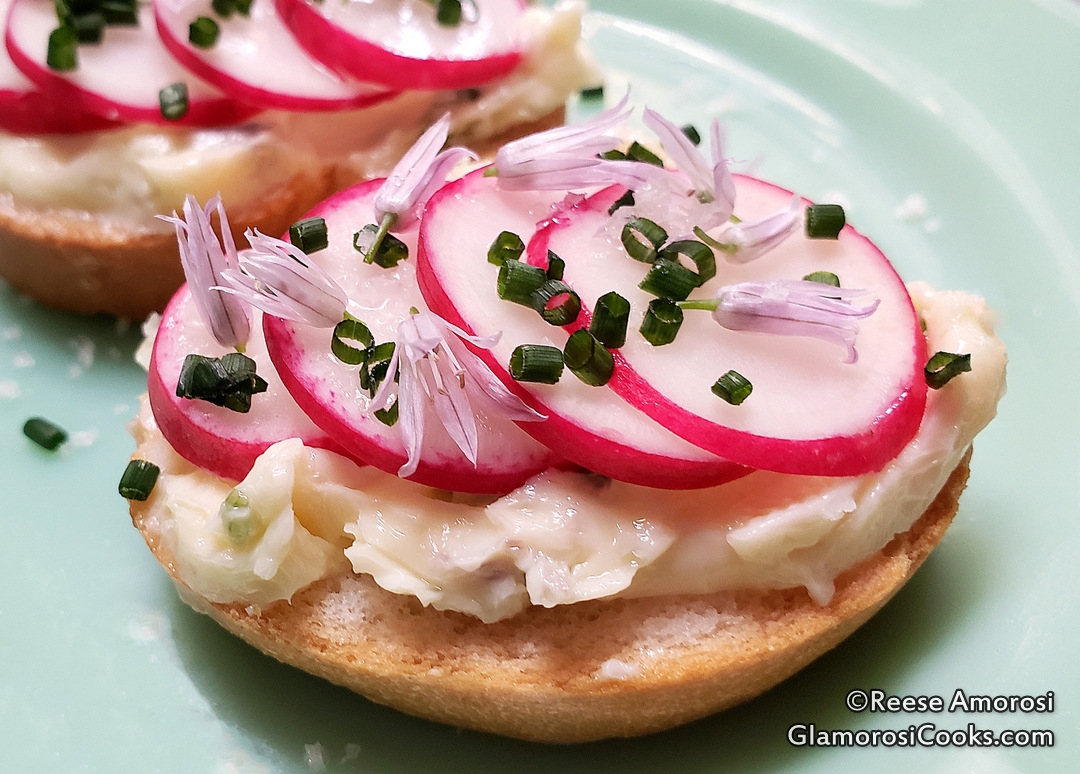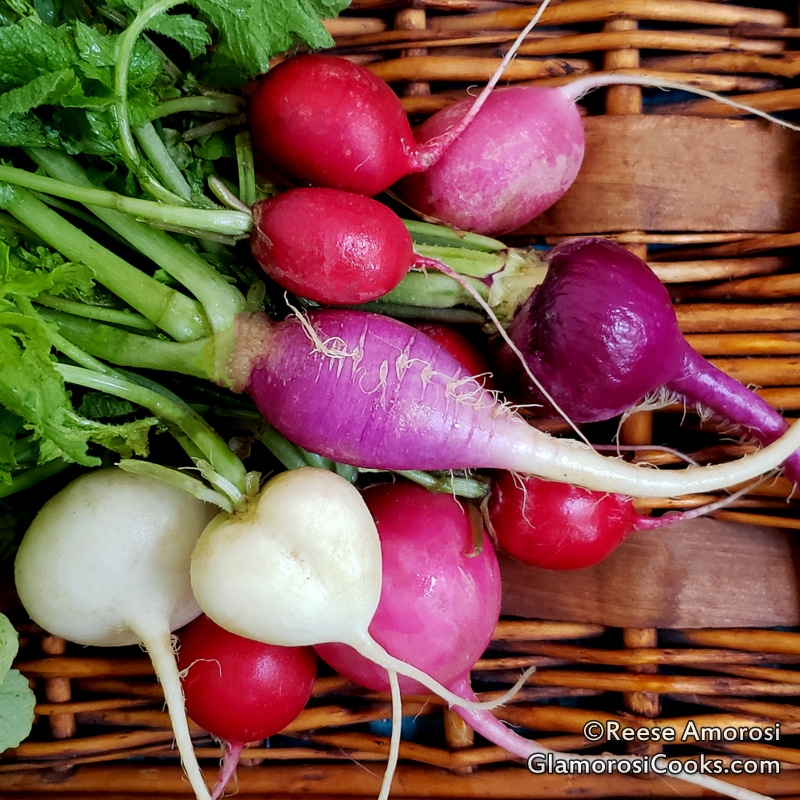By REESE AMOROSI
The radish (Raphanus sativus) is a colorful, cool season, edible annual that is a member of the Brassicaceae or Cruciferae family that includes cabbage, broccoli and turnips. In this article you will learn how to grow Spring radishes and Winter radishes, how to harvest and use them, and tips about our favorite varieties.
Spring Radishes vs. Winter Radishes
Radishes are noted for their crisp texture and sweet but peppery flavor (from very mild with no peppery taste to quite hot), and there are hundreds varieties grown around the globe. Some can take the summer heat, but they are generally divided into two groups: Spring radishes and Winter radishes.
About Spring Radishes…
Spring radishes thrive in cool soil – you can begin planting them as the soil is workable. In my area (Zone 7b) we start planting radishes once our spring flower bulbs start poking through the soil. Spring radishes are a faster, less shelf-stable crop than Winter radishes. They usually go from seed to table in 30 days or less, and can be stored for about a week. Spring radishes are more often milder (some with little or no peppery taste) than winter radishes. They are also smaller – most round Spring varieties are less than two inches in diameter, while Winter varieties can be softball sized or larger. Many Spring radishes can be planted again in the Fall – we get a quick crop in the ground over the Labor Day weekend.
Some of our favorite Spring radishes:
- D’Avignon radish (French Breakfast radish) – Pre-1885. 21-28 days, 3-4 inches long. Attractive, oblong red roots with white bottoms. D’Avignon’s delicate flavor is mildly spicy in cool weather but becomes more spicy in warmer weather. They are traditionally eaten fresh with butter and sea salt, and also with baguette. This variety also does well when sown again in the Fall.
- Pink Beauty radish – 28 days 1 inch round, sweet, minimal heat. We like this radish for its sweet, mild taste, consistent size, resistance to becoming pithy, and its lovely magenta color. The radishes in the main photo for the Glamorosi Cooks Radish Toast recipe are Pink Beauty radishes.
- White Hailstone radish – Early 1900s, 28 days. 1.5 to 2 inches. Round, white skin and flesh, mild and crisp. When I was a kid, all of my family elders grew this radish. It is considered one of the tastiest varieties.
- Easter Egg radish – 1-2 inches, 30 days. Generally a seed mix with a variety of heirloom radishes in colors including red, light pink, rosy pink, violet, purple and bi-color. With multiple varieties in one pack, you will naturally get a staggered harvest because they mature at different times. We love roasting these, they are tasty and pretty on the table. The main photo for this article shows Easter Egg radishes from our garden in Spring 2019.
About Winter Radishes…
Sow Winter radishes from mid-Summer through Fall when the shorter days encourage root growth. Winter radishes grow slower and larger than their Spring counterparts, and they tend to be starchier. They also have a much longer shelf life – you can keep them in the ground (but pull before it freezes), or store in a cool room or fridge for months.
Some of our favorite Winter radishes:
- Watermelon radish (aka Chinese Red Meat radish) – 65 days, 3-4 inches. This ravishing radish is round with white and green skin and a pink-red center. Sliced thin and served raw, it makes a gorgeous addition to salads and vegetable platters. We plant this radish very early Spring and Fall.
- Black Spanish radish – 16th century. 60-70 days, 5 inches. This is a round radish with black skin and white flesh, it makes a great presentation in dishes when you peel the skin to have alternate black and white stripes. In terms of taste, it is one of the hotter radishes.
- Japanese Long Scarlet radish – Pre 1870. 25-40 days, 6 inches long (it looks like a slender carrot), red skin, white flesh, mild. This variety can be used raw in salads, but we grow it for making tasty, gorgeous pickles. You can use this recipe, but of course switch the cucamelons for radishes.
- Chinese Shawo Fruit radish – 60 days, 6-10 inches long. This is an unusual radish that tastes like a mix of melon, cucumber and pear. It has brilliant lime green skin and flesh that gets sweeter after a frost. Not your usual radish, but definitely worth growing.
How to Grow Radishes
Radishes are a fast, fun, easy crop to grow; all you need is a container or small patch of ground in sun or part sun. Direct sow radish seeds in fertile, well-draining soil that is free of rocks and debris so the roots can grow unencumbered. All of the radishes we grow are from heirloom seed – they are easily found online.
Spring radishes: start 4-6 weeks before last frost, every 1-2 weeks until warm weather.
Winter radishes: start 8-10 weeks before first frost, succession planting weekly for 3-4 weeks.
Plant two seeds per inch, depth of one half inch, rows 12 inches apart. When your radish sprouts are an inch tall, thin them to 2-3 inches so they’ll have room to form bulbs (the baby radish greens are edible). Over-crowded radishes lead to long, thin roots, or even crop failure.
Consider doing a succession planting – planting seeds every week or so – to grow a steady supply of fresh radishes maturing at intervals.
How to Harvest Radishes
Harvest when you can see around an inch of radish top popping out of the soil. Radishes left in the ground too long they will get woody (hard), pithy (spongy), or they may split (split radishes are edible if no other issues are present).
When possible, only harvest the amount of radishes you need for any given meal. If you do have to store radishes, be sure to remove the radish greens before putting the radishes in the crisper. This is so the greens don’t pull moisture from the roots. The greens are edible (see below).
If the weather gets too hot for your radishes they will bolt, meaning they will start to produce flowers and seeds. We let some of our radishes bolt on purpose: bees love the flowers and we love eating the delicious green seed pods.
When a radish bolts it sends up a flower stalk and forms seed pods. If you are saving seeds, wait until the pods and stalks are brown and dry. Then, pick them and let them completely dry for a few more days. Open the pods and remove the seeds, and be sure to label them with the variety and date. Radish seeds keep for several years.
It is important to note that radishes readily cross-pollinate, and it recommended to plant varieties at least a half mile apart. Cross-pollination won’t affect the taste or look of your current crop, but seeds you collect may not come true-to-type. The half-mile spacing is easier to follow in rural settings and/or larger farms and gardens. In rowhome gardens like mine – and community gardens – even if YOU only grow one type of radish, your NEIGHBOR may be growing another.
I suggest that you don’t stress about radish spacing. Grow what you like, eat the seed pods, and purchase new seeds as needed. Or, take a chance and grow your possibly cross-pollinated seeds – I have, with no odd results – but don’t offer them in seed exchanges since you cannot guarantee the purity of the seed.
If you don’t harvest your radish seeds and leave them in your garden, they will self-seed.
How to Use Radishes
 All parts of the radish are edible: the root is, of course, but the leaves, flowers and seed pods are as well.
All parts of the radish are edible: the root is, of course, but the leaves, flowers and seed pods are as well.
Radishes are less spicy when cooked. They can be sautéed, roasted or poached, and are wonderful in stir fry meals.
Raw radishes add a nice crunch when added to salads. Our favorite way to eat them is raw with butter and salt, especially when prepared using our recipe for Radish Toast with Chive Blossom Butter.
**********
If you enjoy gardening, you may also like How to Grow, Harvest and Cook Cucamelons.

